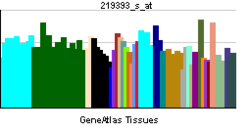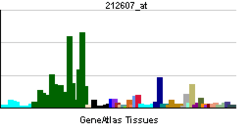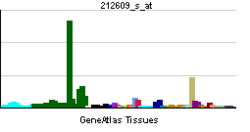AKT3
| V-akt murine thymoma viral oncogene homolog 3 | |||||||||||||
|---|---|---|---|---|---|---|---|---|---|---|---|---|---|
| |||||||||||||
| Identifiers | |||||||||||||
| Symbols | AKT3 ; MPPH; PKB-GAMMA; PKBG; PRKBG; RAC-PK-gamma; RAC-gamma; STK-2 | ||||||||||||
| External IDs | OMIM: 611223 MGI: 1345147 HomoloGene: 55904 IUPHAR: 2286 ChEMBL: 4816 GeneCards: AKT3 Gene | ||||||||||||
| EC number | 2.7.11.1 | ||||||||||||
| |||||||||||||
| RNA expression pattern | |||||||||||||
 | |||||||||||||
 | |||||||||||||
 | |||||||||||||
| More reference expression data | |||||||||||||
| Orthologs | |||||||||||||
| Species | Human | Mouse | |||||||||||
| Entrez | 10000 | 23797 | |||||||||||
| Ensembl | ENSG00000117020 | ENSMUSG00000019699 | |||||||||||
| UniProt | Q9Y243 | Q9WUA6 | |||||||||||
| RefSeq (mRNA) | NM_001206729 | NM_011785 | |||||||||||
| RefSeq (protein) | NP_001193658 | NP_035915 | |||||||||||
| Location (UCSC) | Chr 1: 243.49 – 243.85 Mb | Chr 1: 177.02 – 177.26 Mb | |||||||||||
| PubMed search | |||||||||||||
RAC-gamma serine/threonine-protein kinase is an enzyme that in humans is encoded by the AKT3 gene.[1][2]
Function
The protein encoded by this gene is a member of the AKT subfamily of serine/threonine protein kinases. AKT kinases are known to be regulators of cell signaling in response to insulin and growth factors. They are involved in a wide variety of biological processes including cell proliferation, differentiation, apoptosis, tumorigenesis, as well as glycogen synthesis and glucose uptake. This kinase has been shown to be stimulated by platelet-derived growth factor (PDGF), insulin, and insulin-like growth factor 1 (IGF1). Alternatively splice transcript variants encoding distinct isoforms have been described.[3] Mice lacking Akt3 have a normal glucose metabolism (no diabetes), have approximately normal body weight, but have a 25% reduction in brain mass. Incidentally, Akt3 is highly expressed in the brain.
Interactions
AKT3 has been shown to interact with Protein kinase Mζ.[4]
References
- ↑ Brodbeck D, Cron P, Hemmings BA (Apr 1999). "A human protein kinase Bgamma with regulatory phosphorylation sites in the activation loop and in the C-terminal hydrophobic domain". J Biol Chem 274 (14): 9133–6. doi:10.1074/jbc.274.14.9133. PMID 10092583.
- ↑ Nakatani K, Sakaue H, Thompson DA, Weigel RJ, Roth RA (Jun 1999). "Identification of a human Akt3 (protein kinase B gamma) which contains the regulatory serine phosphorylation site". Biochem Biophys Res Commun 257 (3): 906–10. doi:10.1006/bbrc.1999.0559. PMID 10208883.
- ↑ "Entrez Gene: AKT3 v-akt murine thymoma viral oncogene homolog 3 (protein kinase B, gamma)".
- ↑ Hodgkinson CP, Sale EM, Sale GJ (2002). "Characterization of PDK2 activity against protein kinase B gamma". Biochemistry 41 (32): 10351–9. doi:10.1021/bi026065r. PMID 12162751.
Further reading
- Li W, Zhang J, Bottaro DP, Pierce JH (1997). "Identification of serine 643 of protein kinase C-delta as an important autophosphorylation site for its enzymatic activity.". J. Biol. Chem. 272 (39): 24550–5. doi:10.1074/jbc.272.39.24550. PMID 9305920.
- Borgatti P, Zauli G, Colamussi ML, Gibellini D, Previati M, Cantley LL, Capitani S (1998). "Extracellular HIV-1 Tat protein activates phosphatidylinositol 3- and Akt/PKB kinases in CD4+ T lymphoblastoid Jurkat cells.". Eur. J. Immunol. 27 (11): 2805–11. doi:10.1002/eji.1830271110. PMID 9394803.
- Walker KS, Deak M, Paterson A, Hudson K, Cohen P, Alessi DR (1998). "Activation of protein kinase B beta and gamma isoforms by insulin in vivo and by 3-phosphoinositide-dependent protein kinase-1 in vitro: comparison with protein kinase B alpha". Biochem. J. 331 ( Pt 1) (Pt 1): 299–308. PMC 1219352. PMID 9512493.
- Nakatani K, Thompson DA, Barthel A, Sakaue H, Liu W, Weigel RJ, Roth RA (1999). "Up-regulation of Akt3 in estrogen receptor-deficient breast cancers and androgen-independent prostate cancer lines". J. Biol. Chem. 274 (31): 21528–32. doi:10.1074/jbc.274.31.21528. PMID 10419456.
- Masure S, Haefner B, Wesselink JJ, Hoefnagel E, Mortier E, Verhasselt P, Tuytelaars A, Gordon R, Richardson A (1999). "Molecular cloning, expression and characterization of the human serine/threonine kinase Akt-3". Eur. J. Biochem. 265 (1): 353–60. doi:10.1046/j.1432-1327.1999.00774.x. PMID 10491192.
- Murthy SS, Tosolini A, Taguchi T, Testa JR (2000). "Mapping of AKT3, encoding a member of the Akt/protein kinase B family, to human and rodent chromosomes by fluorescence in situ hybridization". Cytogenet. Cell Genet. 88 (1–2): 38–40. doi:10.1159/000015481. PMID 10773662.
- Meucci O, Fatatis A, Simen AA, Miller RJ (2000). "Expression of CX3CR1 chemokine receptors on neurons and their role in neuronal survival". Proc. Natl. Acad. Sci. U.S.A. 97 (14): 8075–80. doi:10.1073/pnas.090017497. PMC 16672. PMID 10869418.
- Hartley JL, Temple GF, Brasch MA (2001). "DNA Cloning Using In Vitro Site-Specific Recombination". Genome Res. 10 (11): 1788–95. doi:10.1101/gr.143000. PMC 310948. PMID 11076863.
- Zauli G, Milani D, Mirandola P, Mazzoni M, Secchiero P, Miscia S, Capitani S (2001). "HIV-1 Tat protein down-regulates CREB transcription factor expression in PC12 neuronal cells through a phosphatidylinositol 3-kinase/AKT/cyclic nucleoside phosphodiesterase pathway". FASEB J. 15 (2): 483–91. doi:10.1096/fj.00-0354com. PMID 11156964.
- Kapasi AA, Fan S, Singhal PC (2001). "Role of 14-3-3epsilon, c-Myc/Max, and Akt phosphorylation in HIV-1 gp 120-induced mesangial cell proliferation". Am. J. Physiol. Renal Physiol. 280 (2): F333–42. PMID 11208609.
- Wiemann S, Weil B, Wellenreuther R, Gassenhuber J, Glassl S, Ansorge W, Böcher M, Blöcker H, Bauersachs S, Blum H, Lauber J, Düsterhöft A, Beyer A, Köhrer K, Strack N, Mewes HW, Ottenwälder B, Obermaier B, Tampe J, Heubner D, Wambutt R, Korn B, Klein M, Poustka A (2001). "Toward a Catalog of Human Genes and Proteins: Sequencing and Analysis of 500 Novel Complete Protein Coding Human cDNAs". Genome Res. 11 (3): 422–35. doi:10.1101/gr.GR1547R. PMC 311072. PMID 11230166.
- Sandirasegarane L, Kester M (2001). "Enhanced stimulation of Akt-3/protein kinase B-gamma in human aortic smooth muscle cells". Biochem. Biophys. Res. Commun. 283 (1): 158–63. doi:10.1006/bbrc.2001.4739. PMID 11322783.
- Brodbeck D, Hill MM, Hemmings BA (2001). "Two splice variants of protein kinase B gamma have different regulatory capacity depending on the presence or absence of the regulatory phosphorylation site serine 472 in the carboxyl-terminal hydrophobic domain". J. Biol. Chem. 276 (31): 29550–8. doi:10.1074/jbc.M104633200. PMID 11387345.
- Mende I, Malstrom S, Tsichlis PN, Vogt PK, Aoki M (2001). "Oncogenic transformation induced by membrane-targeted Akt2 and Akt3". Oncogene 20 (32): 4419–23. doi:10.1038/sj.onc.1204486. PMID 11466625.
- Zinda MJ, Johnson MA, Paul JD, Horn C, Konicek BW, Lu ZH, Sandusky G, Thomas JE, Neubauer BL, Lai MT, Graff JR (2001). "AKT-1, -2, and -3 are expressed in both normal and tumor tissues of the lung, breast, prostate, and colon". Clin. Cancer Res. 7 (8): 2475–9. PMID 11489829.
- Laine J, Künstle G, Obata T, Noguchi M (2002). "Differential regulation of Akt kinase isoforms by the members of the TCL1 oncogene family". J. Biol. Chem. 277 (5): 3743–51. doi:10.1074/jbc.M107069200. PMID 11707444.
- Deregibus MC, Cantaluppi V, Doublier S, Brizzi MF, Deambrosis I, Albini A, Camussi G (2002). "HIV-1-Tat protein activates phosphatidylinositol 3-kinase/ AKT-dependent survival pathways in Kaposi's sarcoma cells". J. Biol. Chem. 277 (28): 25195–202. doi:10.1074/jbc.M200921200. PMID 11994280.
- Hodgkinson CP, Sale EM, Sale GJ (2002). "Characterization of PDK2 activity against protein kinase B gamma". Biochemistry 41 (32): 10351–9. doi:10.1021/bi026065r. PMID 12162751.
External links
- AKT3 human gene location in the UCSC Genome Browser.
- AKT3 human gene details in the UCSC Genome Browser.